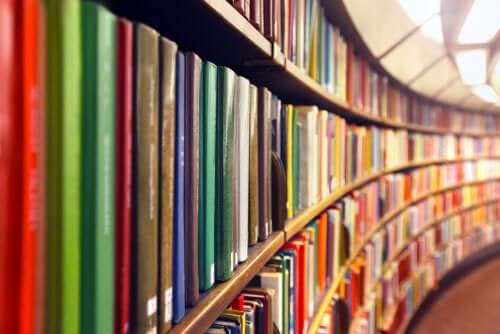Differences Between the School Library and Classroom Library

Libraries are essential in children’s lives. That’s because they’re excellent resources for fostering their imagination, creativity, curiosity, and personal development. In addition to the public libraries and special children’s libraries that they can attend, there are also two more types: the school library and the classroom library.
However, it’s true that in many schools there’s only one of the two and, unfortunately, in some, libraries aren’t present at all.
The school library vs. the classroom library
The first type of library we’ll refer to is, without a doubt, the best known: the school library. This type of library is located in a specific area of the school and houses children’s books on different topics. What’s more, these books are organized according to the different ages of the children in the school.

- Promoting reading
- Encouraging expression, creativity and imagination
- The organization of activities around reading
As indicated by Camacho Espinosa, the school’s educational project should include the school library, its functions, organization and objectives. As Spain’s Organic Law of Education indicates in its article 113: “School libraries will contribute to promoting reading and giving the student access to information and other resources for learning in other areas.“
In addition to all of the above, the school library must have a series of characteristics to make it a good space.
Accessibility
When we talk about accessibility, we mean both the physical space and the schedule that the school library has. Also, its location must be a place that all children are able to access.
It’s a good idea for the school library to be accessible both from inside and outside the school, especially in case it’s open during non-school hours.
Also take into account that it must be a space with a design that’s accessible to all. By this we mean avoiding stairs or any kind of impediment for children with any kind of disability. And, as far as the schedule goes, it’s advisable for school libraries to remain open during all school hours and even outside of them. Of course, as long as there are sufficient means and personnel to do so.
Funding
In today’s digital era, its advisable for libraries to have both physical books and e-books. They should also possess children’s educational and didactic applications, as well as audiovisual materials. In addition, and as a further promotion of the space and its funds, it’s good for children to be able to borrow books, within the framework of a series of policies and rules of use.
Activities
Another way to encourage the use of the school library is through the organization of activities that take place there. For example, storytelling events, book presentations, and workshops on a particular book can help children approach libraries in a totally playful way.

The classroom library
The second type of library that can be found in schools is the classroom library. The first of the differences between the school library and the classroom library is that the latter is much less known than the former.
The intent of the classroom library is mainly for the last cycle of pre-school and kindergarten education and the first cycle of elementary school. In this sense, they differ from the school library, which has the purpose of welcoming all types of children in the school.
What we’re trying to achieve with the classroom library is a closer approach to books, as opposed to the vision of the entire book collection in the school library.
The location is obviously another difference between the school library and the classroom library. On the one hand, the school library is located in a specific space of the school. On the other hand, the classroom library is located, as its name indicates, within the different school classrooms.
In short, the classroom library is a more specialized space according to the children’s ages and their way of accessing information, which needs to be more within their reach.
Libraries are essential in children’s lives. That’s because they’re excellent resources for fostering their imagination, creativity, curiosity, and personal development. In addition to the public libraries and special children’s libraries that they can attend, there are also two more types: the school library and the classroom library.
However, it’s true that in many schools there’s only one of the two and, unfortunately, in some, libraries aren’t present at all.
The school library vs. the classroom library
The first type of library we’ll refer to is, without a doubt, the best known: the school library. This type of library is located in a specific area of the school and houses children’s books on different topics. What’s more, these books are organized according to the different ages of the children in the school.

- Promoting reading
- Encouraging expression, creativity and imagination
- The organization of activities around reading
As indicated by Camacho Espinosa, the school’s educational project should include the school library, its functions, organization and objectives. As Spain’s Organic Law of Education indicates in its article 113: “School libraries will contribute to promoting reading and giving the student access to information and other resources for learning in other areas.“
In addition to all of the above, the school library must have a series of characteristics to make it a good space.
Accessibility
When we talk about accessibility, we mean both the physical space and the schedule that the school library has. Also, its location must be a place that all children are able to access.
It’s a good idea for the school library to be accessible both from inside and outside the school, especially in case it’s open during non-school hours.
Also take into account that it must be a space with a design that’s accessible to all. By this we mean avoiding stairs or any kind of impediment for children with any kind of disability. And, as far as the schedule goes, it’s advisable for school libraries to remain open during all school hours and even outside of them. Of course, as long as there are sufficient means and personnel to do so.
Funding
In today’s digital era, its advisable for libraries to have both physical books and e-books. They should also possess children’s educational and didactic applications, as well as audiovisual materials. In addition, and as a further promotion of the space and its funds, it’s good for children to be able to borrow books, within the framework of a series of policies and rules of use.
Activities
Another way to encourage the use of the school library is through the organization of activities that take place there. For example, storytelling events, book presentations, and workshops on a particular book can help children approach libraries in a totally playful way.

The classroom library
The second type of library that can be found in schools is the classroom library. The first of the differences between the school library and the classroom library is that the latter is much less known than the former.
The intent of the classroom library is mainly for the last cycle of pre-school and kindergarten education and the first cycle of elementary school. In this sense, they differ from the school library, which has the purpose of welcoming all types of children in the school.
What we’re trying to achieve with the classroom library is a closer approach to books, as opposed to the vision of the entire book collection in the school library.
The location is obviously another difference between the school library and the classroom library. On the one hand, the school library is located in a specific space of the school. On the other hand, the classroom library is located, as its name indicates, within the different school classrooms.
In short, the classroom library is a more specialized space according to the children’s ages and their way of accessing information, which needs to be more within their reach.
All cited sources were thoroughly reviewed by our team to ensure their quality, reliability, currency, and validity. The bibliography of this article was considered reliable and of academic or scientific accuracy.
- Camacho, J. (2004). La biblioteca escolar en España. Ediciones de la Torre.
- BOE. Ley Orgánica 2/2006, de 3 de mayo, de Educación. Boletín Oficial del Estado, 4 de mayo de 2006.
- Marzal, J. (1991). Biblioteca de centro y la biblioteca de aula. Castalia y Ministerio de Educación y Ciencia..
- Fuentes, J. (2006). La biblioteca escolar. Arco Libros.
This text is provided for informational purposes only and does not replace consultation with a professional. If in doubt, consult your specialist.








